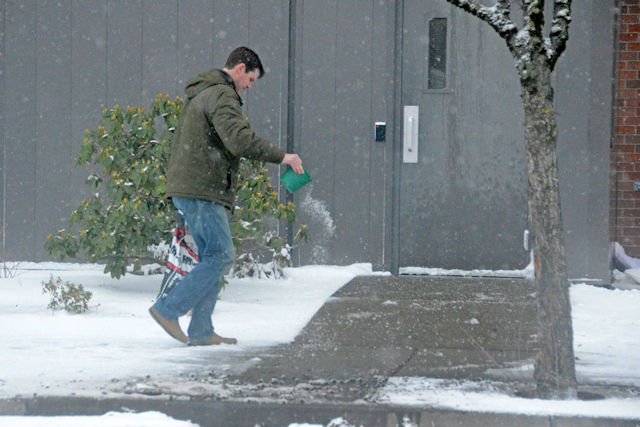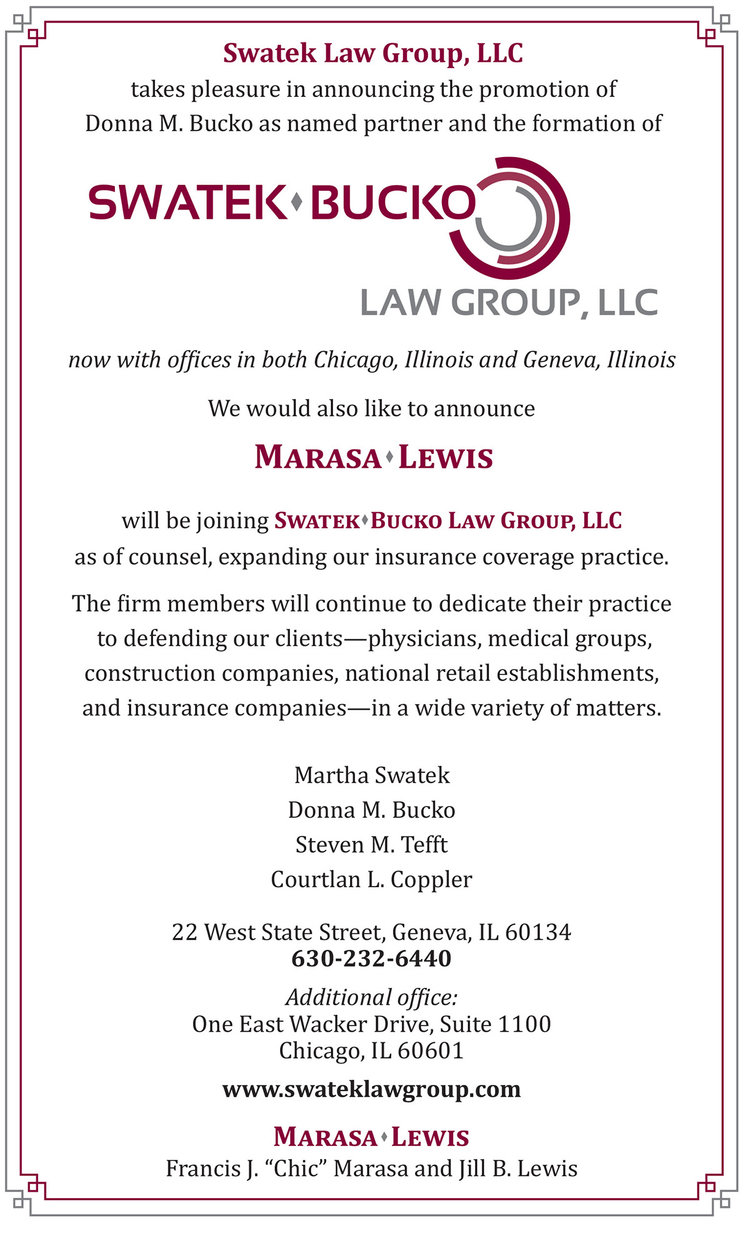Recent Announcements
Posted:

In its recent opinion in Hussey v. Chase Manor Condominium Association, the First District Appellate Court of Illinois addressed the question of what constitutes a “sidewalk” under the Illinois Snow and Ice Removal Act (the “Act”).
The Act is intended to encourage owners and others to remove snow and ice from sidewalks abutting their properties and contains an immunity provision that provides as follows:
“Any owner, lessor, occupant or other person in charge of any residential property, or any agent of or other person engaged by any such party, who removes or attempts to remove snow or ice from sidewalks abutting the property shall not be liable for any personal injuries allegedly caused by the snowy or icy condition of the sidewalk resulting from his or her acts of omissions unless the alleged misconduct was willful or wanton.” 745 ILCS 75/2 (emphasis added).
In Hussey, the plaintiff, Rita Hussey, slipped and fell on a patch of ice in the rear of her Chicago condominium building on March 15, 2014. The area where the plaintiff fell was primarily used for parking vehicles but was also used as a walking path to access the building’s laundry room, basement and utility room. A day or two before the incident, following a heavy snowfall, the condominium association directed the man they hired for snow removal to plow the snow in the rear of the building. He did so and piled the snow against the rear of the building. The plaintiff estimated that the pile of snow was around 5 ½ feet high. The rear area had a downward slope, so the pile of snow against the building’s wall was above the area where the plaintiff fell. As the plaintiff was walking through the rear area to the laundry room, she slipped and fell on a patch of ice near the building.
The plaintiff filed a complaint for negligence against the condominium association (both directly and for the acts of its agent, the man who removed the snow) as well as the condominium association’s management company. The plaintiff’s theory, which was supported by an expert affidavit, was that the snow pile melted when the temperatures warmed; following gravity’s course, the melted snow travelled downhill onto the parking-lot pathway; the temperatures dropped again, causing the water to re-freeze; and, thus, ice formed on the parking-lot pathway.
The defendants moved for summary judgment, arguing that they had immunity under the Act for removing or attempting to remove snow and ice from “sidewalks abutting the property.” The trial court agreed and entered summary judgment in their favor. The plaintiff appealed.
On appeal, the First District identified the issue on appeal as: what the Act means when it immunizes snow-removal efforts on “sidewalks abutting the property.” The First District analyzed a number of prior appellate court cases arriving at differing and contradictory results and ultimately found that the area behind the building where the plaintiff fell did not meet the Act’s definition of a “sidewalk abutting the property.”
First, the First District noted that the Act was in derogation of the common law. Consequently, the Act (and its immunity) must be strictly construed to avoid eliminating by implication a body of common law claims.
Second, the First District focused on the Act’s use of the word “abutting” to modify “property.” The First District noted that the Act does not refer to sidewalks abutting, for example, a “house,” but rather to sidewalks abutting a “property”: “[The Act] does not refer to sidewalks bordering the house, which is a far broader reading of the Act that permits the inclusion of all sorts of private walkways leading from the house, not to mention front and back porches.”
Finally, the First District noted that, while one might use the word “sidewalk” in a colloquial sense to refer to a paved walkway on private property leading to a house, the Illinois General Assembly has always used “sidewalk” as a term of art (as have the courts interpreting that word) in contexts outside the Act. In such other contexts, the First District noted that the term of art “sidewalk” has always referred to public, not private property.
Consequently, the First District reversed the trial court’s entry of summary judgment in favor of the defendants and remanded the case, writing: “We do not read the phrase ‘sidewalks abutting property’ of a residential landowner as including walkways on private property. We read the phrase as limited to the municipal right-of-way, the part of the public street reserved for pedestrian use that abuts private residential property. Thus, regardless of whether plaintiff’s accident occurred in a ‘parking area,’ a walkway or pathway on private property, or a hybrid of both, it did not occur on a ‘sidewalk’ within the meaning of the Snow and Ice Removal Act.”
Posted:
A question that arises frequently in Illinois premises liability cases is the scope of a commercial tenant’s duty to provide a safe ingress and egress to and from the tenant’s business.
Under Illinois law, an owner or occupier of a premises has a duty to provide a safe ingress and egress from the premises. Reed v. Galaxy Holdings, Inc., 914 N.E.2d 632, 636 (1st Dist. 2009). In limited situations, that duty may extend beyond the precise boundaries of the premises. Hanks v. Mount Prospect Park District, 614 N.E.2d 135, 139 (1st Dist. 1976). The duty will extend beyond the precise boundaries of the premises where (1) the business took affirmative action to appropriate the sidewalk; (2) the sidewalk was in disrepair and used exclusively to access the business; or (3) the business directly and immediately contributed to the injury. See Hougan v. Ulta Salon, Cosmetics & Fragrance, Inc., 999 N.E.2d 792, 803 (2nd Dist. 2013).
A recent (unpublished) case from the Second District Appellate Court of Illinois, Thomas v. M.A. Dynasty, Inc., 2017 IL App (2d) 170024-U, illustrates the application of the above principles to a common fact pattern: a slip-and-fall on a sidewalk outside the business.
In Thomas, the plaintiff filed a lawsuit against her hair salon after she slipped and fell on a sidewalk outside the salon. The salon leased its storefront from the building’s landlord. The lease provided that the salon was responsible for all “interior (non-structural)” maintenance and repairs of the leased premises. The lease provided that the landlord, on the other hand, was required to provide maintenance for the exterior and all “structural parts of the Leased Premises, and Complex, the sidewalks and the parking lot.” The lease also required the landlord to provide snow removal services for the parking lot and sidewalks.
In her complaint, the plaintiff alleged that, pursuant to the lease, the hair salon had a duty to maintain the salon’s ingress and egress in a reasonably safe manner and that the salon breached this duty when it allowed a gutter pipe with a hole in it to splash water and form ice near the entrance to the salon. The trial court granted summary judgment for the salon, reasoning that the salon did not owe the plaintiff a duty because the plaintiff did not fall in front of the salon but rather “further down” the sidewalk near the downspout/gutter. The trial court further reasoned that, as evidenced by the lease, the landlord assumed full responsibility for maintenance of the sidewalk outside the salon. Finally, the trial court found that the salon’s duty to provide a safe ingress and egress to and from the premises did not extend beyond the boundaries of the premises because the salon did not undertake care of the sidewalk or commandeer the sidewalk for its exclusive use. The plaintiff appealed.
On appeal, the Second District Appellate Court of Illinois affirmed the trial court’s entry of summary judgment for the salon, holding that the salon’s duty to provide a safe ingress and egress did not extend beyond the leased premises.. The Second District, relying on Hougan, found that the salon did not owe the plaintiff a duty of care because the sidewalk on which she fell was under the exclusive control of the landlord. Like the trial court, the Second District also noted that the plaintiff did not fall near the entrance to the salon but rather farther down the sidewalk near the downspout/gutter. Finally, the Second District found that none of the exceptions that would extend the salon’s duty of care beyond the leased premises applied: there was no evidence that the salon controlled the sidewalk, appropriated the sidewalk for its exclusive use, or otherwise directly contributed to the plaintiff’s injury.
Posted:

The First District Appellate Court of Illinois recently affirmed summary judgment in favor of a property owner and snow-removal contractor and addressed the applicability of Illinois’ “natural accumulation” rule in Allen v. Cam Girls, LLC, 2017 IL App (1st) 163340.
In Allen, the plaintiff, Robin Allen, alleged that she was injured when she slipped and fell in the parking lot of a strip mall. Allen sued, among others, the property owner, Alliance Investment Source, LLC (“Alliance”), and Alliance’s snow-removal contractor, ZL Landscaping, Inc. (“ZL”), alleging that their negligent maintenance of the parking lot led to an unnatural accumulation of ice and snow that caused her to fall.
Alliance and ZL moved for summary judgment, arguing that Allen could not prove negligence because she could not identify the cause of her fall. Specifically, the defendants pointed out that Allen could not state with certainty whether she fell on ice and that she did not see any standing or accumulated water on the day she fell. ZL also argued that there was no evidence that it breached its contract with Alliance because Alliance instructed ZL not to salt the lot and there was less than two inches of snow on the ground at the time of Allen’s fall (the contract only required snow removal after snowfalls of two or more inches).
In response, Allen argued that Alliance breached its duty under its lease with its tenant to salt the parking lot and remove ice, while ZL breached its duty under its contract with Alliance to properly plow the lot. Allen also argued that the parking lot was plowed negligently in a way that led to unnatural accumulations of snow and ice. In support of this latter theory, Allen attached affidavits from two retained experts.
The trial court granted summary judgment for Alliance and ZL.
On appeal, Allen argued that the trial court erred in granting summary judgment because (1) there was a material issue of fact as to whether the defendants could be held liable under a voluntary undertaking theory and (2) there was a material issue of fact as to whether the defendants’ actions created an unnatural accumulation of snow and ice.
The First District preliminarily noted that, under the common law, a property owner has no general duty to remove natural accumulations of snow and ice. Accordingly, a plaintiff in a slip-and-fall case involving snow and ice must demonstrate that (1) the accumulation of snow or ice was unnatural and (2) the property owner had actual or constructive notice of the condition.
Nevertheless, the First District also noted that a property owner (or someone else) may voluntarily undertake the removal of natural accumulations of snow and ice and that, if they do so, they must exercise reasonable care in the process. In that case, a defendant’s tort liability to third parties is governed by Section 324A of the Restatement (Second) of Torts, which provides:
“One who undertakes, gratuitously or for consideration, to render services to another which he should recognize as necessary for the protection of a third person or his things, is subject to liability to the third person for physical harm resulting from his failure to exercise reasonable care to protect his undertaking, if
(a) his failure to exercise reasonable care increases the risk of such harm, or
(b) he has undertaken to perform a duty owed by the other to the third person, or
(c) the harm is suffered because of reliance of the other or the third person upon the undertaking.”
Allen argued that when a defendant is contractually obligated to remove natural accumulations of snow and ice, a plaintiff who slips and falls on a natural accumulation of snow and ice is entitled to recover in tort. The First District noted that Illinois appellate courts are split on the question of whether there is an exception to the natural accumulation rule in cases where a party is contractually obligated to remove snow and ice, but found that there was no need to resolve the split because the case law favorable to Allen only created an exception to the rule where no snow removal at all had been performed. The First District noted that, in Allen’s case, it was undisputed that the parking lot had been plowed prior to Allen’s fall. Because the lot had been plowed prior to Allen’s fall, Allen was required to set forth evidence that the plowing created an unnatural accumulation of snow or ice that caused her fall.
With respect to the existence of an unnatural accumulation, the First District cited the affidavits of Allen’s experts as creating evidence of unnatural accumulations of ice in the parking lot on the date of the incident. The First District noted, however, that despite this evidence, the trial court properly entered summary judgment in favor of the defendants because Allen could not establish a causal nexus between those unnatural accumulations and her fall. At her deposition, Allen had testified that she did not know whether she fell on ice:
“COUNSEL FOR ALLIANCE: Do you know if you stepped upon a patch of ice that was underneath the snow or if the snow in and of itself was slippery?
ALLEN: I’m just assuming that it was ice, but I don’t know that for sure. I mean, the way I went down and the fact that I went down so fast made me think that there was ice under the snow.
Q. But you can’t say with any degree of certainty if it was a patch of ice that you slipped on, correct?
A. I did not see any ice, but I did see snow.
Q. Since you didn’t see any ice, would you agree that any statement that you would have tripped on ice would be a guess on your part?
A. It would be a guess on my part.”
The First District noted that, under Illinois law, a plaintiff must set forth “positive and affirmative proof of causation” and that summary judgment for defendants is proper where the plaintiff has no evidence regarding the cause of her fall. Given that Allen could only “assum[e]” and “guess” that she had slipped on ice, she could not link her fall to the defendants’ snow-removal procedures. Consequently, the trial court’s entry of summary judgment in favor of Alliance and ZL was proper.
Posted:

The question in Calloway v. Bovis Lend Lease, Inc. is whether the defendant construction manager can be held liable for injuries to a construction worker caused by a contractor hired by the owner. Calloway v. Bovis Lend Lease, Inc. 2013 IL App (1st) 112746. Based on the recent decision of Calloway, the answer is yes.
Liability of construction managers in this situation is analyzed under Section 414 of the Restatement (Second) of Torts which states:
“One who entrusts work to an independent contractor, but who retains the control of any part of the work, is subject to liability for physical harm to others for whose safety the employer owes a duty to exercise reasonable care, which is caused by his failure to exercise his control with reasonable care.”
In Calloway v. Bovis Lend Lease, Inc., the defendant construction manager argued in its appeal following a jury verdict in favor of the plaintiff that it did not entrust any work to the subcontractor who was performing work at the time of the accident because it did not hire or enter into a contract with the subcontractor Calloway v. Bovis Lend Lease, Inc. 2013 IL App (1st) 112746.
In support of its contention, the construction manager in Calloway cited the recent decision of O’Connell v. Turner Construction Co., 409 Ill.App.3d 819, 949 N.E.2d 1105 (1st Dist. 2011). In O’Connell, a school district entered into a contract with the construction manager and the construction manager handled the bidding process for hiring subcontractors; however, the actual signatories on the contracts were the school district and the contractors and subcontractors. The O’Connell court noted that the prerequisite to analyzing a case under Section 414 of the Restatement (Second) of Torts was whether the defendant entrusted work to an independent contractor and absent such entrustment Section 414 would not apply. The O’Connell court noted under those facts that the construction manager did not entrust work to any contractors or subcontractors and therefore the plaintiff’s claim under Section 414 failed.
The Calloway court agreed with other federal court decisions that the issue of entrustment, like that of control, should be decided based upon whether the circumstances of each case showed that the construction manager actually entrusted work to a subcontractor and not based upon a bright-line test such as whether the construction manager actually signed a contract with the subcontractor. The Callowaycourt stated that a construction manager could meet the control requirement when there is evidence that the construction manager’s actions demonstrate that it retained a sufficient level of control, even where contractual language exists formally assigning control to the independent contractor. The Calloway court held that entrustment should be evaluated in the same manner. Therefore, the court found that the entrustment requirement could be satisfied when the totality of circumstances demonstrated that the construction manager actually entrusted work to a subcontractor even if the construction manager did not actually sign the contract with the subcontractor. TheCalloway court stated that the defendant’s argument that entrustment could only be found if it signed the contract with the subcontractor was “overly narrow and formalistic” and therefore the court declined to adopt it. If the defendant’s argument was accepted, the court noted that it would allow “project owners, construction managers and general contractors to easily avoid the reach of Section 414.” Therefore, theCalloway court held that there was sufficient evidence that the defendant entrusted its work to the subcontractor to create a question of fact for the jury.


